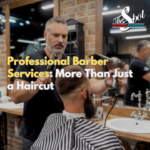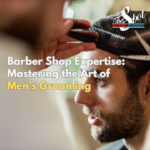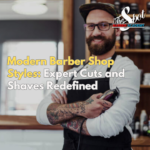Introduction
Barbering, an age-old profession, has seen a resurgence in recent years, blending traditional techniques with modern trends. This renaissance not only revives classic styles but also introduces innovative approaches to men’s grooming. In this comprehensive guide, we will delve into the world of modern barbering techniques, exploring how the fusion of old and new is reshaping the barbering landscape.

The Modern Barbering Renaissance
The modern barbering renaissance is a testament to how traditional craft can adapt and thrive in a contemporary setting. This resurgence is not just about bringing back classic styles but reimagining them in a way that resonates with today’s sensibilities.
Rebirth of Classic Styles
In recent years, we’ve witnessed a revival of classic haircuts and techniques. Styles like the slick back, side part, and the fade have made a strong comeback, often blended with modern twists. This revival isn’t just about nostalgia; it’s about appreciating the timelessness of these styles and the skill involved in creating them.
The Role of Fashion and Pop Culture
Fashion and pop culture play significant roles in the modern barbering renaissance. Movies, music icons, and celebrities often set trends, reviving old styles or introducing new ones. The influence of these mediums has transformed barber shops into trendsetting hubs, where old-school meets new-school.
The Art of Grooming: More Than Just Haircuts
Today’s barbering transcends haircuts and shaves. It’s about the overall grooming experience. Services like beard trimming, facial massages, and skincare treatments have become integral parts of the modern barbering repertoire, catering to the growing demand for comprehensive grooming services.
A Focus on Experience and Atmosphere
Modern barber shops are more than just places to get a haircut; they are destinations offering unique experiences. The interior design often reflects a blend of vintage and contemporary aesthetics, creating an inviting atmosphere. Many shops also offer complimentary beverages, music, and a friendly environment, making each visit a memorable experience.
Technological Integration in Barbering
The integration of technology has revolutionized the way barber shops operate and interact with clients. Online booking systems, digital portfolios, and social media presence have become standard practices, enhancing efficiency and customer engagement.
Advanced Tools and Techniques
Technology has also impacted the tools used in barbering. Lightweight, cordless clippers with various settings, ergonomic razors, and advanced hair care products have become essential in modern barber shops. These tools not only make the job easier and more efficient but also allow for a higher degree of precision and creativity in haircuts and styles.

The Roots of Barbering
Barbering’s history is as rich and varied as the styles it creates. This profession, originating from the Latin word ‘barba,’ meaning beard, has been an integral part of human culture since ancient times. Barber shops in ancient civilizations were not just places for grooming; they were social hubs, spaces for community interaction, and even forums for political discussions.
Ancient Civilizations and Barbering
In ancient Egypt, barbers were highly respected individuals. They served pharaohs and priests, ensuring their hair and beards were immaculately groomed, signifying cleanliness and purity, which were vital in religious and social contexts. The tools they used were rudimentary compared to today’s standards, often crafted from bronze and oiled to ensure smooth operation.
The Greeks and Romans further elevated barbering, integrating it into their daily life and culture. For Greeks, a clean-shaven face represented youth and beauty, while for Romans, visiting a barber shop was a daily ritual, crucial for maintaining personal appearance and social status. These cultures were among the first to create specialized barbering tools and introduce the concept of professional barber shops.
The Barber-Surgeon Era
During the Middle Ages, barbers did more than just cut hair. They were also surgeons, a combination that might seem odd today. Known as barber-surgeons, they performed a wide range of services, including dentistry, bloodletting, and minor surgical procedures. This period highlighted the barbers’ versatility and their importance in society.
Barber-surgeons were identifiable by the iconic barber pole, a symbol that still represents the profession today. The pole’s red and white spirals symbolize the blood and bandages associated with their surgical role, a nod to their historical medical functions.
The Decline and Separation of Barber-Surgeons
The separation of barbering from surgery began in the late 18th century, with the rise of professional medicine. As surgery became more scientific, it distanced itself from barbering, which remained focused on grooming. This led to the establishment of barbering as a distinct profession, solely dedicated to hair cutting, styling, and shaving.
The 19th and 20th Century: Barbering Becomes a Craft
In the 19th and 20th centuries, barbering began to be recognized as a craft. Barbershops became staples in communities, places where men congregated not just for grooming but also for conversation and camaraderie. During this period, several of the traditional techniques that are still popular today were perfected, such as the hot towel shave, a practice that remains a quintessential experience in modern upscale barber shops.
Barbering in the Modern Era
As we moved into the modern era, the role of the barber continued to evolve. The 20th century saw a rise in the barber’s status as a stylist and a confidant. Hair styles like the flat-top, the crew cut, and other tailored styles became symbols of the times, reflecting broader cultural and fashion trends.
The late 20th and early 21st centuries have seen a resurgence in the appreciation for traditional barbering techniques, dovetailing with a renewed interest in personalized grooming services. This renaissance has redefined the barber’s role, blending their rich historical legacy with the ever-changing trends of the modern world.
As we continue to explore the evolution of barbering techniques, from the ancient world to the modern-day, it’s clear that this profession has not only adapted to the times but has also helped shape them. This rich history sets the stage for understanding how traditional techniques are being integrated into modern practices, creating a dynamic and evolving craft that continues to captivate and inspire.
The Education Evolution in Barbering
As barbering techniques evolve, so does the need for comprehensive education. Modern barbering schools now offer courses that go beyond basic hair cutting and shaving. They cover a wide range of topics, including hair and scalp health, advanced styling techniques, customer service, and business management.
Emphasis on Personal Style and Creativity
In the modern era, barbers are encouraged to develop their unique style and approach. This personalization is what sets them apart in a competitive market. It’s not just about replicating classic cuts; it’s about adding a personal touch, understanding client needs, and staying true to one’s artistic vision.
Sustainability and Ethical Practices
There’s also a growing focus on sustainability and ethical practices in barbering. This includes using eco-friendly products, minimizing waste, and adopting practices that are not only good for business but also for the environment and community.
Fusion of Old and New
The true beauty of modern barbering lies in the seamless blend of traditional and contemporary techniques. Barbers today are not only skilled in classic cuts but are also adept at incorporating modern trends like textured crops, fades, and undercuts.
Customization: The Key to Modern Barbering
Customization is at the heart of modern barbering. Each client is unique, and understanding their personal style, hair type, and lifestyle is crucial. This tailored approach ensures that each haircut is not just a service but an experience.
Educational Focus: Learning Modern Techniques
Aspiring barbers must understand both traditional and modern techniques. This requires a comprehensive educational program that focuses on hands-on experience, theoretical knowledge, and the development of personal style.
The Importance of Continuous Learning
The world of fashion and grooming is ever-evolving. Therefore, continuous learning and adaptation are vital for any barber wishing to stay relevant. This involves keeping up with trends, attending workshops, and being part of a community of professionals who share knowledge and skills.
Health and Safety: A Priority in Barbering
With the close contact nature of barbering, health and safety have always been paramount. Modern barber shops emphasize sterilization and hygiene, using methods and products that ensure client safety without compromising on quality.
Navigating Through the Pandemic
The recent global pandemic brought significant changes to the barbering industry. Adaptations like enhanced sanitization, use of personal protective equipment, and adhering to social distancing have become the new normal, ensuring the safety of both clients and barbers.
The Impact of Social Media on Modern Barbering
Social media has played a pivotal role in the evolution of modern barbering. Platforms like Instagram and YouTube are not just for marketing but also for education and inspiration. They provide a space for barbers to showcase their work, learn new techniques, and connect with a global community.
Building a Brand
For modern barbers, social media is an invaluable tool for building a personal brand. It allows them to display their skills, attract new clients, and establish themselves as experts in the field.
The Future of Barbering
As we look to the future of barbering, it’s poised to undergo even more transformative changes, adapting to new trends, technologies, and societal shifts. The future of this craft is not just about maintaining traditions but also about pushing boundaries and exploring new possibilities.
Embracing Digital Innovation
In the digital age, barbering is set to embrace more technological advancements. Augmented reality (AR) and virtual reality (VR) could become commonplace in barber shops, allowing clients to visualize haircuts and styles before they are executed. This technology will enable a more interactive and personalized experience, reducing the uncertainty that often accompanies a trip to the barber.
Sustainable Practices and Eco-Friendly Products
As environmental concerns continue to rise, the future of barbering will likely see an increased emphasis on sustainability. This could mean more barber shops adopting eco-friendly practices, using biodegradable materials, and focusing on organic, cruelty-free hair care products. This shift not only appeals to environmentally conscious consumers but also contributes to a more sustainable industry.
The Integration of Health and Wellness
Barbering is set to expand beyond hair and facial grooming, integrating more aspects of health and wellness. Scalp health, hair loss treatments, and even stress-relieving therapies could become standard services offered by barbers. This holistic approach positions barber shops not just as places for grooming but as wellness hubs.
Education and Continuous Learning
The importance of education in barbering will continue to grow. With the ever-evolving techniques, styles, and tools, continuous learning will be essential for barbers to stay relevant. This could lead to more advanced training programs, specialized courses, and even online learning platforms dedicated to the art of barbering.
The Rise of Personal Branding
In the future, personal branding for barbers will become increasingly important. Social media and online platforms offer barbers a chance to showcase their work, connect with a broader audience, and build their brand. This not only helps in attracting a loyal clientele but also opens up opportunities for collaborations and endorsements.
Expanding Gender and Cultural Inclusivity
The future of barbering will likely see a greater emphasis on inclusivity. This means catering to a diverse clientele, regardless of gender, hair type, or cultural background. Barber shops will become more welcoming spaces for everyone, breaking down traditional gender barriers and embracing a more global approach to grooming.
The Role of Artificial Intelligence
Artificial intelligence (AI) could play a significant role in the future of barbering. From AI-powered booking and management systems to machine learning algorithms that can suggest styles and treatments based on client data, technology will enhance efficiency and personalization in barber shops.
The Blending of Art and Technology
As technology advances, the line between art and science in barbering will blur. We could see the emergence of cutting-edge tools and machines that allow barbers to achieve levels of precision and creativity previously unimaginable. This fusion of art and technology will redefine what is possible in the world of barbering.
A Future Full of Possibilities
The future of barbering is bright and full of possibilities. It’s a future where tradition meets innovation, where artistry blends with technology, and where the barber’s chair becomes a place for not just grooming but overall well-being. As we look ahead, the world of barbering is set to continue its evolution, promising exciting new trends, techniques, and experiences for both barbers and their clients.
Conclusion: Join Our Journey at The Spot Barber Academy
As we look at the fascinating blend of tradition and trend in modern barbering, it’s clear that this is a dynamic and evolving art form. At The Spot Barber Academy, we are dedicated to training the next generation of barbers, combining time-honored techniques with the latest trends. Our program is designed to equip you with the skills, knowledge, and confidence to excel in this thriving industry. Join our Barbering program, and embark on a journey that is not just a career, but a craft, a passion, and a lifestyle.







